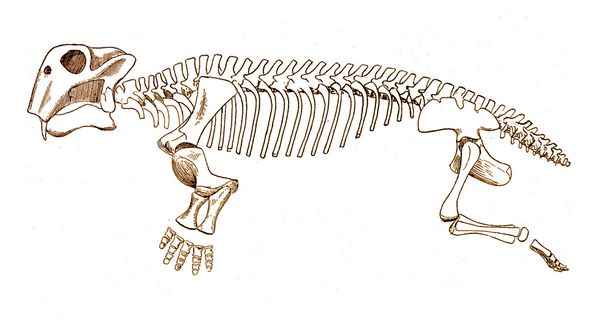Athena Review Image Archive ™
Lystrosaurus skeleton

Skeleton of Lystrosaurus
Lystrosaurus, an herbivorous therapsid, was the most common land animal in the Early Triassic period (252-247 mya). With only two upper canines, and a horny beak that was used for biting off pieces of vegetation, Lystrosaurus ("shovel-lizard") is classed as a dicynodont, or "two dog-teeth" (from di- "two", -cyno "dog" or "canine", and -dont "tooth").
Lystrosaurus was heavily built, approximately the size of a pig, although some species grew up to 2.5 m long. The structure of its shoulders and hip joints suggests that it moved with a semi-sprawling gait. With very robust forelimbs, the animal is thought to have been a powerful digger that nested in burrows.
Lystrosaurus had first appeared at the end of the Permian, and survived the end-of-Permian extinction to flourish in the Early Triassic. Many other groups of land tetrapods disappeared, to be replaced by new forms (Benton 2005). Lystrosaurus fossil species are widespread in the Early Triassic, and very similar throughout the regions where they migrated. The associated environments for this small, terrestial plant-eater are wooded, well-watered riverine settings.
For Early Triassic land vertebrates, a major pattern throughout Gondwanaland (comprising South Africa, India, China, Australia, Antartica, and Russia), included both amphibians and a standard assemblage of reptiles and synapsids known as the Lystrosaurus fauna, after the Early Triassic faunal zone in the South African Karoo Basin. In Gondwanaland this pattern may have carried over from the Late Permian period, when the distribution of dicynodonts accords well with that of forest vegetation, as shown by Glossopteris distribution.
References
Benton, M.J. 2005 . When life nearly died: the greatest mass extinction of all time. London: Thames & Hudson.
Sun, Ailing 1980. Late Permian and Triassic Terrestial Tetrapods of North China. Vertebrata PalAsiatica Vol XVIII, No.2 April, 1980 pp. 100-110
Copyright © 1996-2020 Rust Family Foundation (All Rights Reserved).